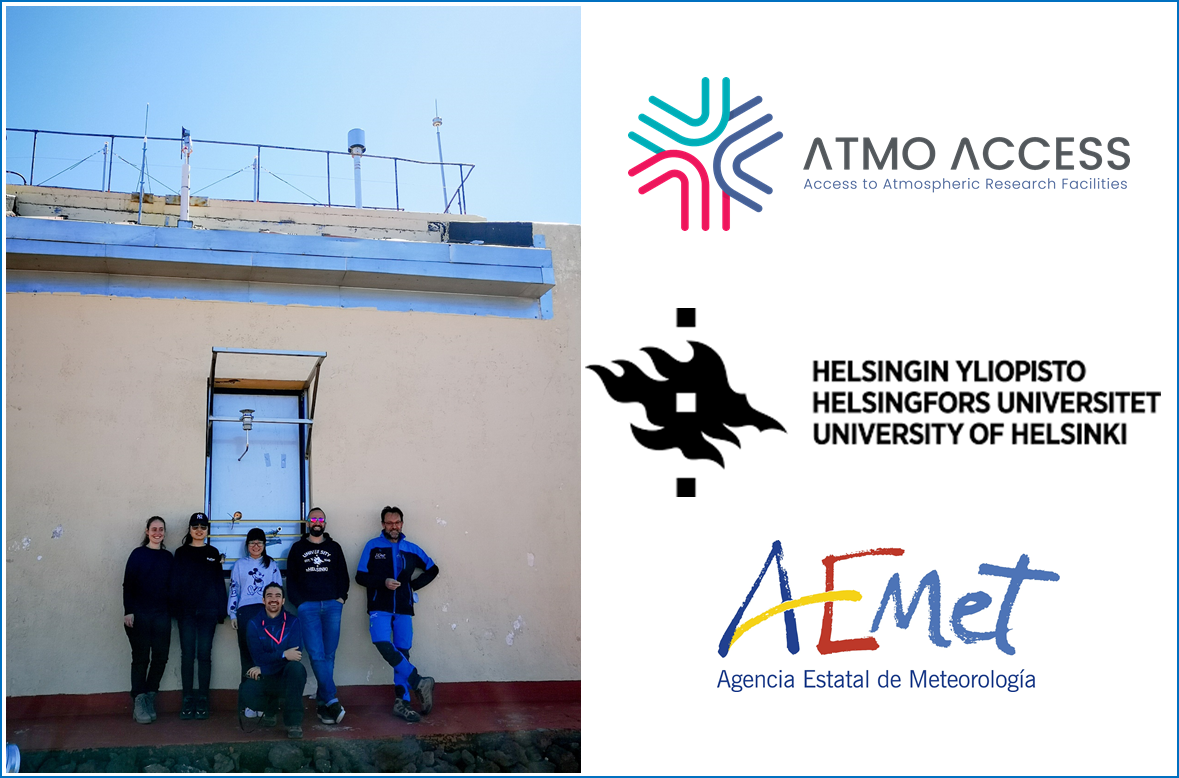
| HOME | PROJECT | TRANS-NACIONAL ACCESS | OFFERED SERVICES | PUBLICATIONS |
|---|
ATMO-ACCESS provides opportunities for accessing 43 of the most advanced operational European atmospheric research facilities in Europe.
How to apply: https://www.atmo-access.eu/tna-call-application/
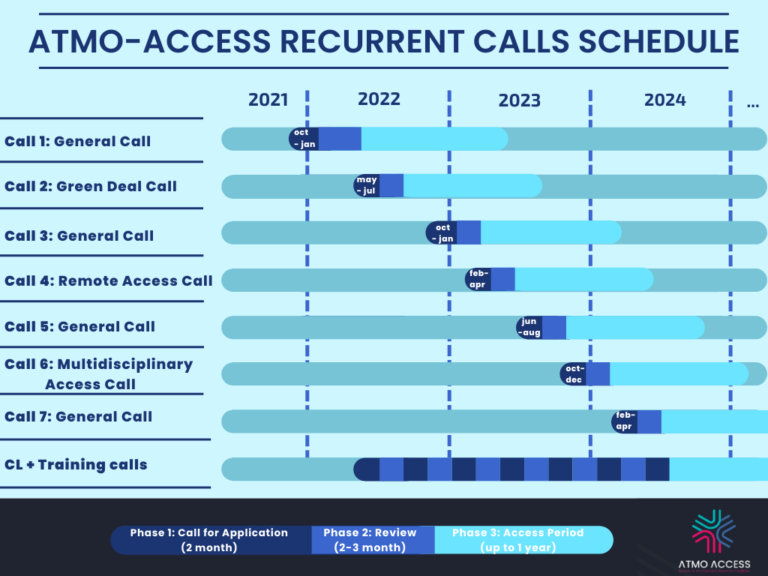
IZAÑA SUBTROPICAL ACCESS FACILITY – ISAF
Izaña Atmospheric Observatory – Meteorological State Agency of Spain
Site type: High mountain remote background
Location: (28.309ºN,16.499ºW, 2373 m a.s.l.)

The Izaña Atmospheric Research Center (IARC) at Meteorological State Agency of Spain (AEMET) is responsible of the Izaña Atmospheric Observatory, a centenary observatory in Tenerife island at 2.400 m aprox asl therefor is normally above a temperature inversion layer, generally well established over the island, and below the descending branch of the Hadley cell. Consequently, it offers excellent conditions for trace gas and aerosol in situ measurements under “free troposphere” conditions, and for atmospheric observations by remote sensing techniques. The environmental conditions and pristine skies are optimal for calibration and validation activities of both ground-based and space-borne sensors, and the geographic location, it is particularly valuable for the investigation of dust transport from Africa to the North Atlantic, long-range transport of pollution from the Americas, and large-scale transport from the tropics to higher latitudes.
Our facilities include an aerosol laboratory for in-situ measurements, an optical laboratory for calibration and characterization of optical instruments, an horizon free terrace and more than 2000 m2 of other laboratories, storage place, etc., devoted to the study of atmospheric constituents, i.e. aerosol, reactive gases and trace gases observations, not only in-situ, but also in column and profiling.
The Izaña Atmospheric Observatory has a long experience in hosting intensive instrument field campaigns and runs comprehensive programmes for monitoring and investigation of greenhouse gases, the ozone layer and related ozone depleting substances, reactive gases, solar radiation, and chemical and physical properties of atmospheric aerosols. Izaña also constitutes an international platform where specific measurements are used to assess observations made on board satellites and simulations from chemical transport models.
AEMET-IARC participates in several observational programs and networks including:
SYNOP (surface synoptic observations) and radio/ozone sonde networks (since 1916)
WMO-GAW (Global Atmospheric Watch)
ICOS (Integrated Carbon Observation System)
ACTRIS (Aerosol, Clouds and Trace Gases Research Infraestructure)
NDACC (Network for Detection of Atmospheric Composition Change)
TCCON (Total Carbon Column Observing Network)
BSRN (Baseline Surface Radiation Network)
AERONET (AErosol RObotic NETwork)
MPLNET (Micropulse Lidar NETwork)
E-GVAP (EUMETNET EIG GNSS water vapour programme)
PANDORA-PANDONIA
EUBREWNET (EUropean BREWer NETwork)
PROJECT
The ambition of ATMO-ACCESS project (from the European Union’s Horizon 2020 research and innovation programme) is to address the needs for developing sustainable solutions based on the principles of open access and to develop guidelines and recommendations for governance, management and funding for efficient and effective access provision suited to distributed atmospheric RIs. This project investigates the most suitable mechanisms that could lead to the sustainable provision of access to atmospheric research infrastructures.
The main objectives of ATMO-ACCESS are:
- to provide coordinated open physical, remote and virtual access to state-of-the-art facilities and services in atmospheric RIs and further enhance their range of products, capabilities and accessibility for a wide range of users, including the private sector
- to engage facilities and their national stakeholders and direct them towards improved harmonisation of access procedures across the different member states, while also exploring modalities by which the use of atmospheric RIs can be further enhanced
- to explore and test new modalities of access that build on the complementarity and synergies among atmospheric RIs and respond to the evolving needs of users in relation to training, research and technology development, innovation and data services
- to identify the most suitable conditions for establishing sustainable access procedures across the EU for distributed atmospheric RIs, involving national and international stakeholders.
Partners involved in the project
Izaña Atmospheric Research Center (AEMET) are involved in:
WP8: Sustainable and strategic framework for access to distributed atmospheric Research Infrastructures: integrates findings from all other WPs to identify the most suitable conditions for making trans-national access sustainable beyond the current EU funding model (through its third party University of Valladolid – Atmospheric Optics Group)
WP9: Implementing access through TNA activities: deals with central management of TNA in the project, enabling both physical and remote access to a large collection of atmospheric research facilities in a coordinated manner.
Young scientists wanting to test out new theories or ideas, scientists working with local authorities on tricky air pollution problems, companies/private sector users developing instruments that need testing can’t miss the opportunity to apply.
Whilst there is no requirement for the user or the service provider to be partners in Green Deal funded projects, alignment with relevant projects such as RI-URBANS or ICOS Cities would be welcome. Users only need to demonstrate how using the ATMO-ACCESS ground-based observation stations, atmospheric simulation chambers, mobile facilities, or central atmospheric science laboratories will enhance ongoing research, development, or innovation activities regarding the Green Deal.
Eligible proposals are selected by an independent selection panel considering scientific excellence, technical merit, innovation and market-driven aspects.
TNA is provided free of charge to the selected users in person (physical access), remotely (remote access) or both, and includes the logistical, technological and scientific support and the specific training that is needed to use the services provided by the facility. To facilitate TNA, users may benefit from a contribution to support some of their travel and local subsistence costs.
ATMO-ACCESS promotes gender equality in scientific research and specifically encourages applications from women.
For more info, please visit: https://www.atmo-access.eu/
This project has received funding from the European Union’s Horizon 2020 research and innovation programme through the ATMO-ACCESS Integrating Activity under grant agreement No 101008004.
TRANS-NACIONAL ACCESS
The fifth H2020 ATMO-ACCESS (“https://www.atmo-access.eu/a-5th-chance-to-access-the-most-advanced-atmospheric-research-facilities-in-europea-5th/) call for TNA (Trans-National Access) is now open and will remain open until 25th September 2023.
The call will be addressed to researchers or research teams from outside Spain. If your group are interested to propose a field experiment (physical or remote) at the Izaña Subtropical Access Facility (ISAF) or your research needs for calibration and/or intercomparison of photometry technics and you want to discuss particularities of access and practicalities before submitting the official TNA application, please contact us (npratsp[at]aemet[dot]es; abarretov[at]aemet[dot]es).
We offer, as ISAF-Obs, synergistic observation of aerosol and trace gases with in-situ and remote sensing techniques, meteorology and radiation (ICOS/INGOS/ACTRIS synergy), intercomparisons with operational instruments (reporting data to worldwide networks and programmes as WMO-GAW, NDACC, etc), study of atmospheric composition in pristine conditions and with desert dust influences, support in specific campaigns to study atmosphere in remote high mountain conditions, for example to study NPF, desert dust aerosols, transatlantic transport, etc. https://izana.aemet.es/observatories/#izo , https://izana.aemet.es/.
Also, as ISAF-CAL, our Facility is available as calibration site for photometric techniques in terms of Langley procedures in pristine conditions (a certificate will be provided) and comparison of photometers with reference instrument enabling improvements and optimization of them. https://izana.aemet.es/column-aerosols/
Potential interested users will be requested to write a short scientific project to be submitted to ATMO-ACCESS for an internal review (more details about the proposal submission is available on the same ATMO-ACCESS web https://www.atmo-access.eu/access-to-services/ “How to Apply”).
TNA calls will be published on the ATMO-ACCESS website along with guidelines and forms for applicants. TNA opportunities will be widely advertised to reach all possible interested users, using different channels.
Incoming proposals will be checked for formal compliance with the EU regulations, logistical and technical feasibility and scientific relevance.
TNA providers and ATMO-ACCESS project office also evaluate the feasibility of contributing in part to users’ travel and subsistence (T&S) expenses, based on the users’ cost estimates and the available budget allocated specifically for this. The opportunity/feasibility of supporting part of the user’s T&S costs and the amount of the contribution will be decided on a case-by-case basis.
In view of the visit and during the access, users can count on:
Physical access will include use of the facilities, as well as help in the preparatory work and training (if needed), and technical and scientific support during the execution.
Remote access will include remote access to instruments with in-situ support by ISAF scientist and technicians.
Calibration certificate will provided in terms of SOPs and QA/QC protocols used.
Also we offered*: Set-up and disassembling, instrument handling and operation, training on the use of the facility, scientific or technical expertise (data handling/use), power with UPS, internet, accommodation facilities (residence with 7 double-rooms) and kitchen, transportation service available on schedule for displacement from Santa Cruz to ISAF, support in customs clearance and paperwork, advice on instrumentation shipping and transport, storage space, security service**.
At the end of your TNA you will be asked to answer a short “Satisfaction survey regarding your stay at Izaña Atmospheric Observatory” that will help us a lot to improve our service.
Do not hesitate to contact us for getting more information. Hoping to see you soon!
* As a remote site, there is no public transport reaching the Observatory. AEMET, wishing to reduce the carbon footprint and as a background measurement station, has contracted a staff transport service to minimize the arrival of private cars at the observatory, and allows the use of it to ISAF users.
** As a remote site, the Observatory has a security perimeter guarded by security personnel 24 hours a day, 7 days a week.
OFFERED SERVICES
| As ISAF-Observation: | As ISAF-Calibration: |
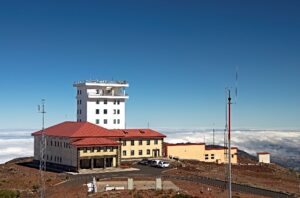 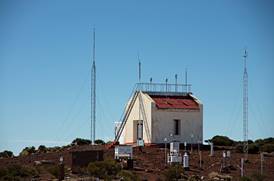 |
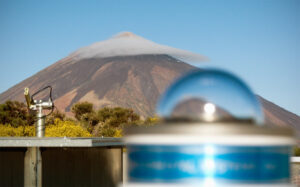 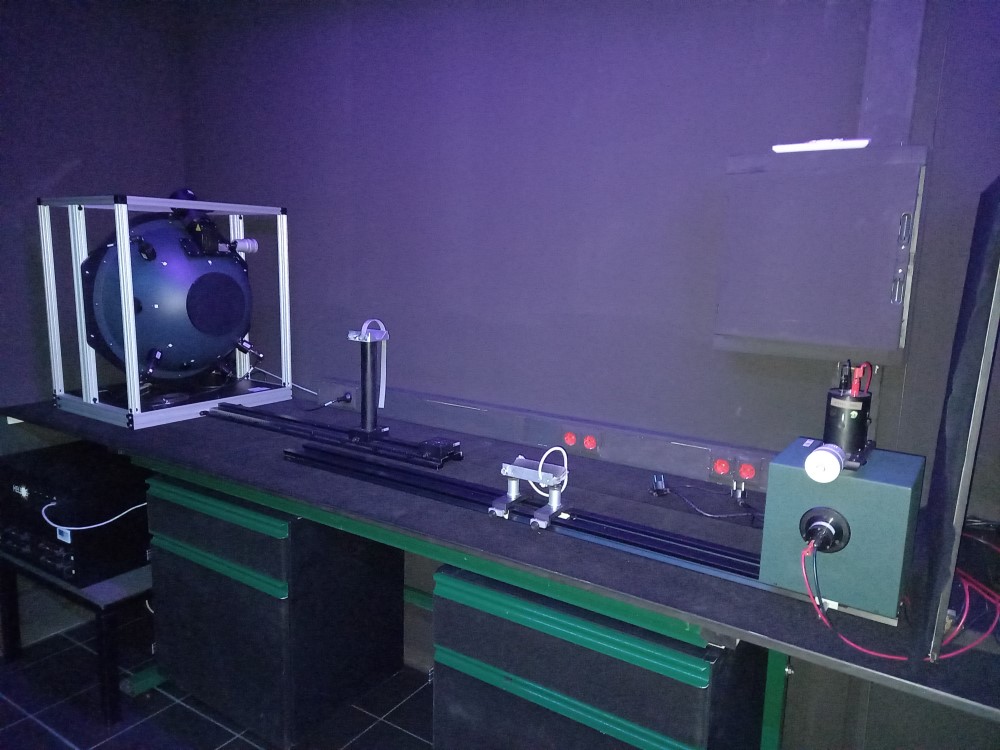 |
| Synergistic observation of aerosol and trace gases with in-situ and remote sensing techniques, meteorology and radiation (ICOS/INGOS/ACTRIS synergy), intercomparisons with operational instruments (reporting data to worldwide networks and programmes as WMO-GAW, NDACC, etc), study of atmospheric composition in pristine conditions and with desert dust influences, support in specific campaigns to study atmosphere in remote high mountain conditions, for example to study NPF, desert dust aerosols, transatlantic transport, etc. Physical access includes use of the facilities, as well as help in the preparatory work and training (if needed), and technical and scientific support during the execution. Remote access includes remote access to instruments with in-situ support by ISAF scientist and technicians. Also offered:
|
Calibration site for photometric techniques in terms of Langley procedures in pristine conditions (a certificate will be provided) and comparison of photometers with reference instrument enabling improvements and optimization of them. Also offered:
|
PUBLICATIONS


This project has received funding from the European Union’s Horizon 2020 research and innovation programme through the ATMO-ACCESS Integrating Activity under grant agreement No 101008004.

